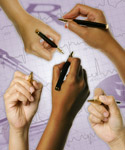June 22nd, 2022
In a Digital World, Is “Legwork” Obsolete?
Khalid A. Shalaby, MBBCh
Our 2021 class of interns was the first in our institution not to receive good old pagers. Many institutions around the country are following suit. This marks a milestone in the advancement of how we communicate in medicine. Gone are the days when residents had to step on toes as they left from the middle seat of a packed grand rounds auditorium to answer a page that now can easily  be answered in a text. We have been heavily reliant on outdated technology like pagers and faxes in healthcare communication, and even though we continue to rely on them in some instances, we are now mostly utilizing secure messaging via HIPAA-approved cell phone applications. As healthcare is rapidly being digitized, is there still a need for “legwork”?
be answered in a text. We have been heavily reliant on outdated technology like pagers and faxes in healthcare communication, and even though we continue to rely on them in some instances, we are now mostly utilizing secure messaging via HIPAA-approved cell phone applications. As healthcare is rapidly being digitized, is there still a need for “legwork”?
There is no denying that digitized healthcare is making strides in ease and efficiency of communication. It has arguably made our patient care safer and more timely, fulfilling some of the Institute Of Medicine’s domains of healthcare quality. While secure messaging is undoubtedly very convenient to answer simple patient care questions from different healthcare team members in real time and to provide updates on a plan that is already in place, it is not meant for nuanced discussions and complex plans of care. All too often, I’ve witnessed myself and others rely too much on secure messaging or electronic health records (EHR) documentation for communication.
During my first weeks of residency, I had a prolonged back and forth text exchange with one of the overnight nurses about a cross coverage question — that left me quite confused. My senior resident who was sitting next to me picked up the phone and advised, “Just call. It’s easier that way.” He was right. As silly as it sounds, it was like I had forgotten that other modes of communication existed. That phone call resolved the questions regarding patient care quite quickly. It was then that I first realized there is a downside of overreliance on digital communication.
 Secure messaging has many pitfalls, one of which is misunderstanding. Especially when trying to convey a complex situation, a simple misunderstanding can have a lot of downstream effects. We cannot appreciate the tone, the level of urgency, the full context, or occasionally even the multiple acronyms used by our colleagues in different specialties. I’ve witnessed many disagreements between different services or healthcare members over secure messaging, but rarely do such disagreements happen during a phone or in-person conversation.
Secure messaging has many pitfalls, one of which is misunderstanding. Especially when trying to convey a complex situation, a simple misunderstanding can have a lot of downstream effects. We cannot appreciate the tone, the level of urgency, the full context, or occasionally even the multiple acronyms used by our colleagues in different specialties. I’ve witnessed many disagreements between different services or healthcare members over secure messaging, but rarely do such disagreements happen during a phone or in-person conversation.
In the past, nonurgent communication with healthcare team members was done primarily on rounds, but now, the answers to all questions are just a text away. The ease with which we can communicate has led to an overwhelming number of messages every day for all clinicians, with the interruptions of an incessantly buzzing phone, making it harder to focus on the task at hand. Not to mention the effects of constant texting on fatigue and burnout among healthcare professionals.
 When placing a consult and waiting for recommendations, I have found it most useful to speak directly with consultants. They almost always welcome a call and are happy to hear our thought process and clinical questions. I learn something from each of these conversations. At times, it’s still beneficial to walk over to the radiology department or the lab/pathology department to have a discussion, provide the clinical context to narrow down differentials, and talk over complex patient care.
When placing a consult and waiting for recommendations, I have found it most useful to speak directly with consultants. They almost always welcome a call and are happy to hear our thought process and clinical questions. I learn something from each of these conversations. At times, it’s still beneficial to walk over to the radiology department or the lab/pathology department to have a discussion, provide the clinical context to narrow down differentials, and talk over complex patient care.
Every generation of healthcare professionals deals with unique challenges. This is certainly one of many we face, especially for those of us who trained entirely in the “post-pager” and EHR era. We must find a way to reap the benefits that technology offers in healthcare delivery and communication and leverage its powers to serve our patients without falling for its shortcomings. This is not a call for resisting the advances in healthcare communication, but rather an acknowledgment of its downsides and a reminder for the need of continued improvement. The answer probably lies in smarter technology and more fluid inter-operability of software. Regardless, we will always need the human touch in healthcare. As these changes continue to shape our healthcare universe, I remind myself and others to be patient, to be kind. Realize that the resolution to a lot of problems can just be a face-to-face/screen-free conversation away.



I fully agree that all communication with staff and colleagues should not be limited to texting, and we have a specific policy about all consults going through our phone service or at least prompting a phone discussion once we are texted. However, I do believe a large percentage of quick messages and responses can be managed with our current technology without our staff developing PTSD from constant pages from those antiquated devices. I still cannot hear the ring of my original housestaff pager tone coming from a distant pager without my heart rate rising about 10 bpm at least, and our old numeric pagers could not sift the urgent info from the banal without us stopping everything to make time for such conversations to determine the level of urgency. Part of training is learning how to communicate with all levels of coworkers in various ways, and I do not believe the pager was necessarily a symbol of better times or superior, efficient communication.
I agree. Thanks for reading.